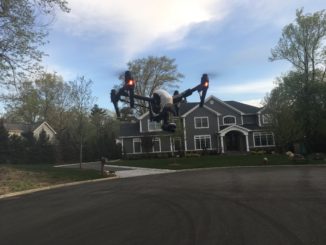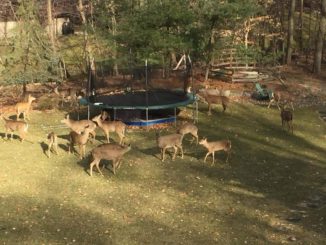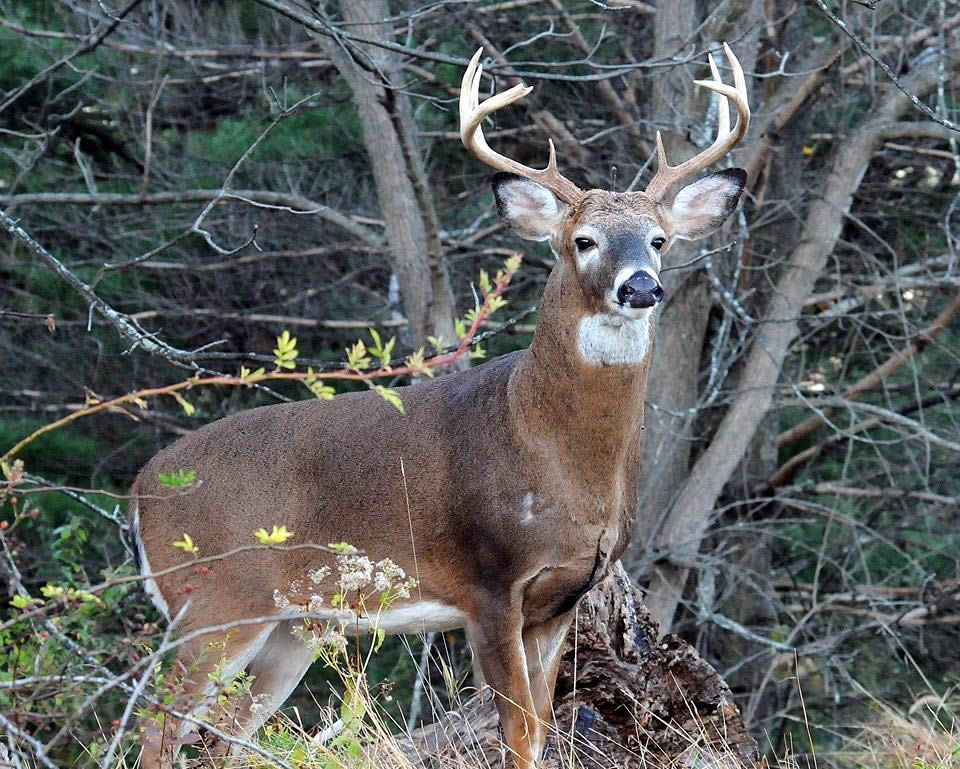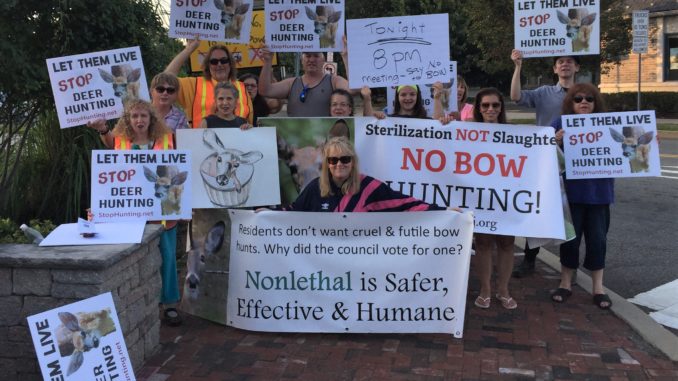
BERGEN COUNTY, N.J.—Although the Bergen County Parks system currently has no plan for dealing with wilidlife management issues—including deer and deer impacts—the director said county parks officials would likely participate in efforts to find a regional solution to address the effects of deer overpopulation.
County Parks & Recreation Director James Koth said the county does not have a wildlife management plan yet as county parks officials have spent the last several years preparing a countywide master plan for its 9,000-acre park system.
However, Koth told Northern Valley Press that county representatives have attended recent meetings that addressed deer issues, including the June 5 Englewood deer forum where public officials expressed strong support for ongoing efforts to create a regional plan to manage and reduce deer numbers.
‘Not solved in a vacuum’
“This problem is not solved in a vacuum,” said Koth, speaking of countywide concerns about deer overpopulation. “It has to happen regionally and with lots of partners participating.”
Koth noted that any regional deer management discussion needs to include all stakeholders and viewpoints.
“I will say this: I think it’s important for us to listen,” he said.
Koth said he agreed with recent reports from area naturalists and nature center managers that excessive deer browsing was destroying understory in certain forested areas, leading to a loss of species diversity.
However, although he said he has seen similar impacts in certain park areas, he noted that deer are not a major concern for parks’ visitors or county parks staff.
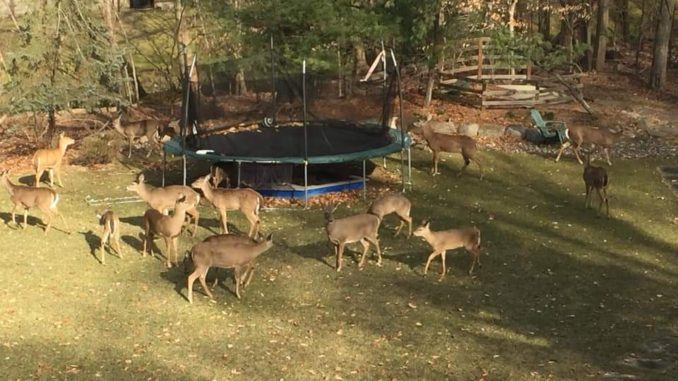
Deer ‘not such an epidemic’
“It’s not like we’re sitting here with our heads in the sand,” Koth said, adding the deer situation is “not such an epidemic that we need to come up with a response to it.”
He said while he agrees deer are destroying forest understory, he doubted whether most residents could relate to such impacts.
“It’s not like it’s some kind of public emergency [and] like everybody is clamoring for action,” he observed. He said county residents are likely more focused on other timely news as opposed to deer concerns.
“The average person has no connection to this [forest understory impacts],” said Koth.
He said towns and residents are more concerned with deer impacts such as public safety (car vs. deer accidents), Lyme disease transmission, and landscape damage.
But Koth said anything short of a regional effort may mean that actions by towns could simply push the deer population elsewhere.
Northern Valley Press reached out to Koth as the Township of River Vale considers a deer hunt on a public golf course to cull the herd, citing a spike in car accidents among concerns. The hunt strategy has drawn considerable opposition from the Animal Protection League and anti-hunting activists, who have staged protests and other outreach initiatives in the township.
Deer strategy ‘a moving target’
Asked about what regional actions might be possible—including lethal and non-lethal options—Koth said effective deer population control is “really a tough thing… It’s a moving target.”
He said “no solution is a one-off solution” that will solve the problem.
Told about River Vale’s decision to conduct a drone deer survey, which found the township deer population at 96 deer per-square-mile—way above the 8-12 recommended by biologists—Koth was asked if the county would consider a deer survey.
“It would certainly be a way to acquire data,” he said, but noted that before anything is done one concern is that people may wrongly perceive why a study is being conducted. He said people on either side of an issue “may misperceive the intent of what you’re doing” by speculating on an end purpose for data being acquired.
Koth repeated that no current policy exists on managing wildlife in county parks, but noted it might be a good idea to investigate such a policy when Bergen County completes its park system master plan.
Koth said his role as director is “to advise” and noted that any policy addressing parks’ wildlife management must take into account “a lot of sensitivities” around deer population control.
He agreed that with Bergen County so densely populated, it would be difficult to enact any type of hunting here, contrasting Bergen’s densely populated areas with more open rural and semi-rural areas in upstate New York counties.
Generally when mayors and public officials discuss deer reduction, discussion turns to county parks, nearby open spaces and whether such lands harbor deer, along with forested land at Palisades Interstate Park and Suez watershed lands.
Previously, PIP director James Hall said 2,500 acres of interstate parkland—adjacent to several towns, including Alpine, Englewood Cliffs and Tenafly—is mostly unsuitable as deer habitat with a parkway and rocky cliff faces dominating its land use.
Suez’s deer dilemma
Suez’s watershed director Ray Cywinski, former Demarest mayor, told local officials in 2018 that the understory in most of 3,200 acres of forested watershed land was completely barren and deer were responsible for the damage.
Cywinski said over four decades of observing forested areas in Bergen, where one could previously not see into the forest because understory growth was so thick, now most places you can see 100-200 feet into a forested area because deer have eaten all plants.
Asked if Suez would participate in a discussion on a regional deer management approach, Cywinski said “everybody’s got to be at the table and we would be…It’s got to be done on a regional basis” including towns, Bergen County, and large private landowners such as private golf course owners.
Cywinski said he sees damage to all 3,200 acres of forest lands Suez owns surrounding its reservoirs in New Jersey and New York.
At a June mayors’ meeting, Upper Saddle River Mayor Joanne Minichetti said Bergen is only one of three counties statewide that does not have a plan for addressing deer management.
While Bergen County lacks a wildlife management plan, other counties with a tradition of hunting such as Monmouth County and even those with no hunting tradition such as densely populated Essex County suburbs, have relied on hunting to reduce deer numbers.
Monmouth County’s Plan
Over 15 years of operation, the Monmouth County Park System has permitted hunting on county lands.
The annual report cited the hunt as part of a continuing effort to “improve forest health and wildlife diversity.”
The report noted deer damage to forests in county parks as “clearly visible … threatening natural resources that were intended to be preserved by the county’s acquisition of the land.”
Over the last three years, hunters have killed more deer, culling 546 in 2016-2017, 604 in 2017-2018, and 687 last year.
In published reports, the county’s assistant parks director, Andrew Spears, called the 2018 cull “a very productive and successful season from a population control standpoint… [with] some leveling off of the deer population. But we have a long way to go,” he said.
Essex County’s plan
In Essex County, published reports show 1,682 deer killed by hunting at permitted county-managed open spaces since 2008.
In Bergen County, only Saddle River—which held a 2018 bowhunt and plans another in 2019—and River Vale, which is currently planning for a fall bowhunt, have approved hunting to reduce local deer populations. Saddle River reported 135 deer killed during its 2018-2019 bowhunt.
After 12 years, Essex County’s deer culling operation received praise from County Executive Joseph DiVincenzo following a culling that removed 200 deer and 100 unborn deer from two county-run reservations.
The culling took place by bowhunters over 12 days from mid-January to early March 2019 in South Mountain and Hilltop Reservations. South Mountain Reservation is located in Maplewood, Millburn and West Orange, and Hilltop Reservation is in Cedar Grove, North Caldwell and Verona.
“Controlling the population by removing deer from South Mountain and Hilltop has proven to be very successful in helping to preserve the forest habitat and maintain our reservations as viable resources for recreation and open space. Each year, we have updated our program to address current conditions, reducing the number of days and transitioning into a ‘maintenance mode’ to maintain the population at a manageable level,” DiVincenzo said in a statement.
“This is just one facet of our comprehensive Deer Management Program that also includes creating seed banks to accelerate the re-growth of the forests and installing reflectors and lights to enhance traffic safety by keeping deer from entering the roadway,” said the executive’s statement.
DiVincenzo said “an aggressive replanting program” to assist forest regrowth of native species is ongoing in 47 locations in South Mountain and Eagle Rock reservations, surrounded by eight-foot-high fences to exclude deer.
He said the county is installing detection devices that reflect vehicle headlights and produce a high-pitched noise when cars approach along four busy area roadways, courtesy of a state transportation grant.

